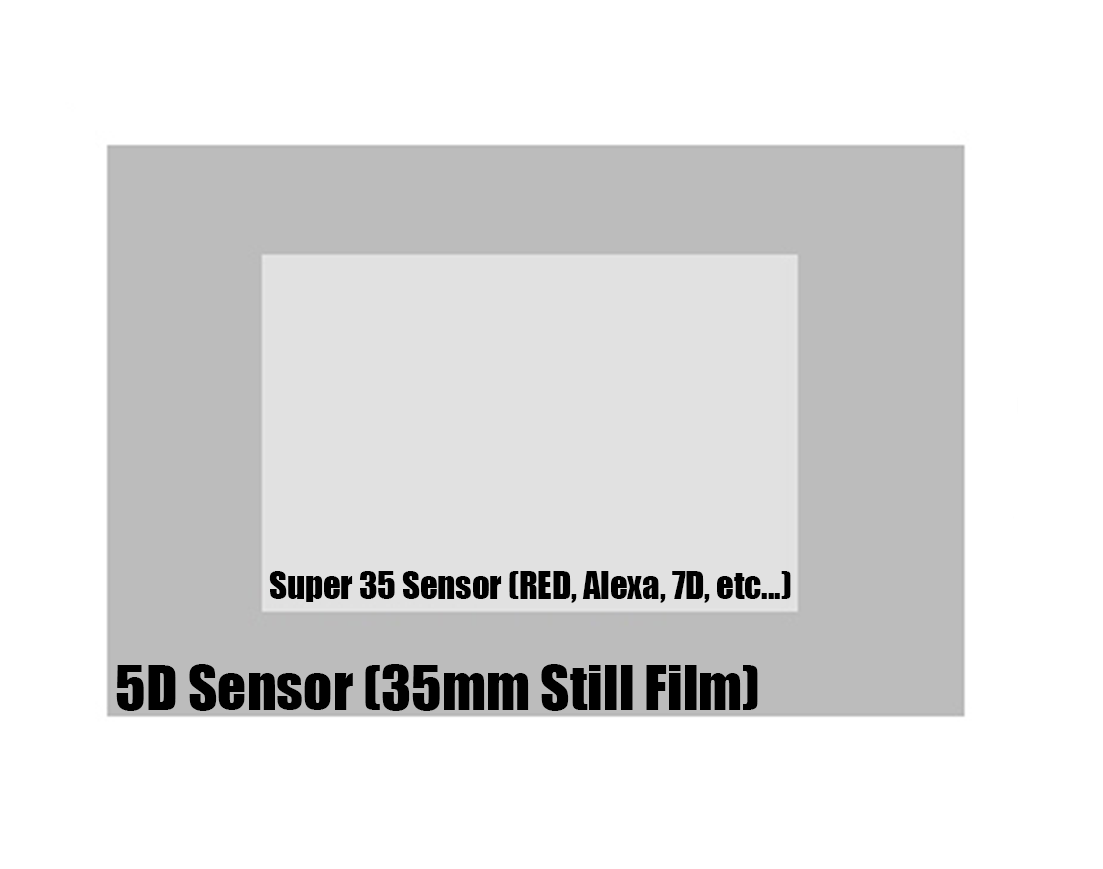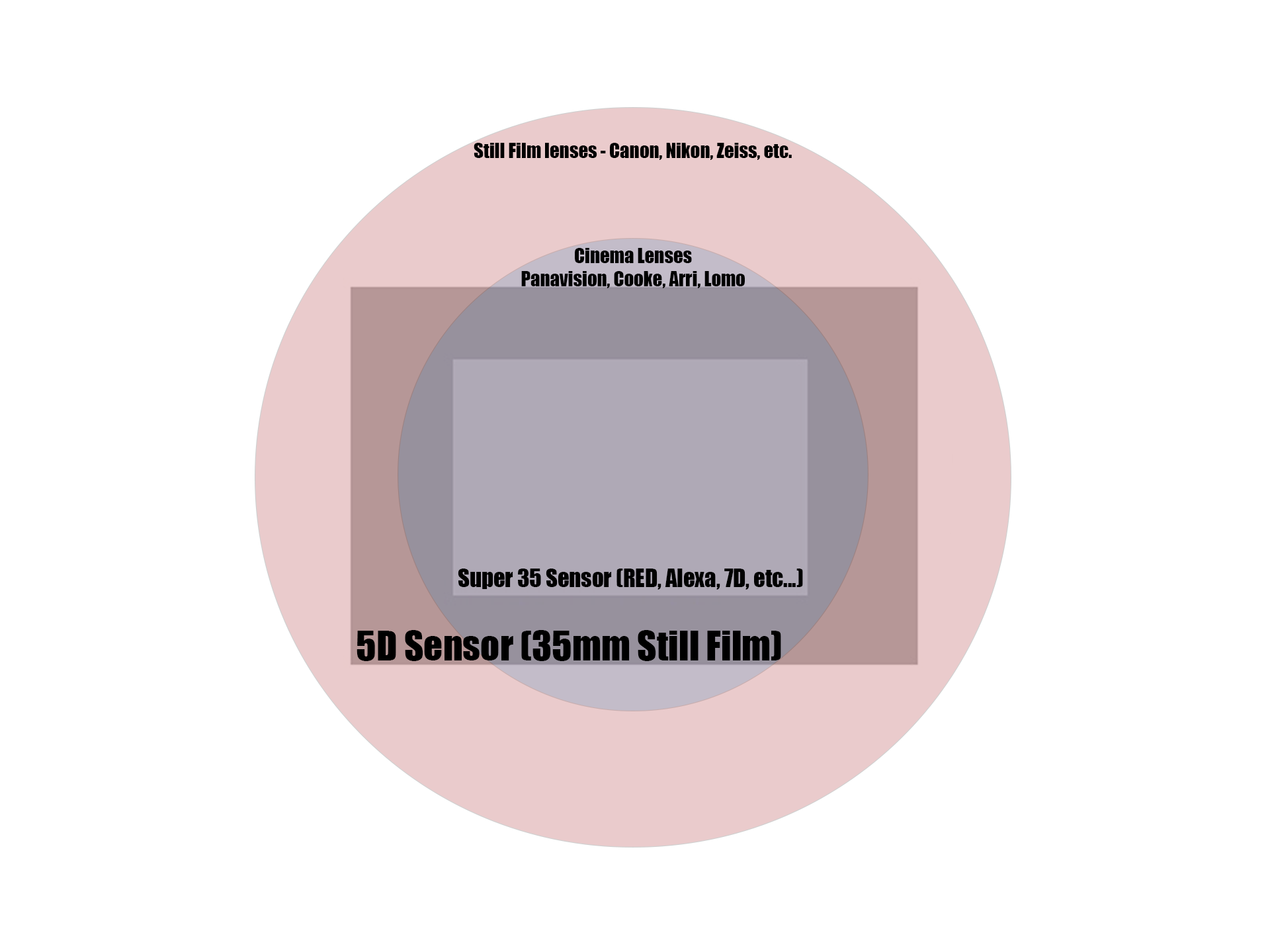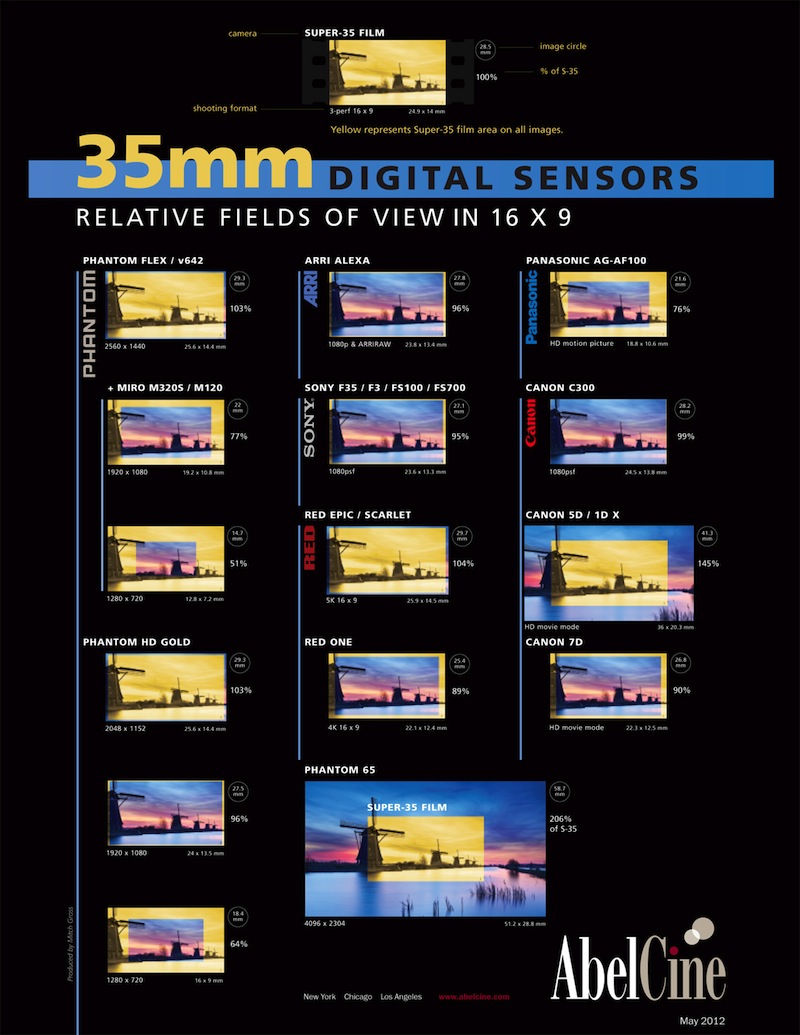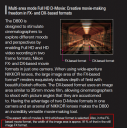
-
I can't tell you how many producers have freaked out over the "crop factor" and thought they needed a 9mm lens to shoot an 18mm shot on the GH2 when using PL mount lenses. So I am here to try to explain this "full frame" nonsense as clearly as possible. (It is important to note that you will still get a little more crop from a 4/3 camera than you will from the RED or the 7D, but it's nominal.)
Okay, for starters:
CP.2s are not real cinema lenses. They are still picture lenses that have been geared with a clickless aperture ring and high end follow focus gears. They don't actually project a cinema sized image circle onto the sensor.

Most DSLR shooters are unaware that every digital cinema camera has a sensor that is ROUGHLY the size of a Super 35mm piece of motion picture film. This is true for the RED, Alexa, F65, Phantom, Genesis, Viper, 7D, GH2, FS100, etc.... The only aberrations are the 5D, 1DX, and (edit) the D800 which have a sensor the size of a 35mm piece of still film.

Most of us use Still Picture lenses (Nikon, Canon, Zeiss, Voightlander, Nokton etc.) on our DSLRs, and as a result, the smaller sensor crops the still frame image circle projected onto it by a factor of anywhere between 1.5x to 2x. Except on the 5D, 1DX, D800 which have a "Full Frame" sensor that takes advantage of the full projection circle from these lenses.
BUT
Cinema Lenses - those big PL mount suckers (Your Cooke, Angenieux, Panavision, Arri, Eagle, Zeiss, etc...) project a smaller image circle which is the size of a Super 35mm piece of motion picture film. Which is why they can't be used with the 5D, and why Zeiss created the CP.2s for DSLR shooters, namely, 5D shooters, who wanted a lens that would project the same "Full Frame" image circle as the ZE and ZF series, but machined to be used with a professional follow focus geared for Cinema Lenses, and would have a manual, clickless aperture ring - just like the big boys.
SO
Using Still Lenses - To get the same framing, the 5D will have to be placed closer to the scene than all the other cameras. (Like almost twice as close)
But when dealing with Cinema lenses on a GH2 (not CP.2s for reasons discussed above), you will not get the same FOV as say a RED or Alexa, but it is nowhere near the drastic 2x crop factor that so many producers seem to think. It's closer to about a 1.25x crop. (So add 25% -- 50mm FOV becomes a 62.5mm FOV, a 14mm FOV becomes a 17.5mm FOV, 18mm FOV becomes a 22.5mm FOV, etc. -- To get this multiply the lens focal length by 1.25.)
Ain't camera technology fun???
-
I believe you are mistaken when you say that a 50mm "still lens" on a 5D "is the equivalent of a 50mm PL mount lens on all other cinema cameras in terms of Field of View". It is not. Focal length is an absolute measurement of the optical dynamics of the lens elements, and is not relative to the size of what the image is being projected on to. I have never heard of a lens manufacturer labelling their lenses according to full frame equivalence. When they say that a lens has a focal length of 50mm, they mean that it is 50mm... not that it would create a field of view on a camera sensor of X by X dimensions equivalent to what 50mm looks like on a 36x34mm sensor.
Crop factor is very relevant if you're accustomed to how lenses look on a 36x34mm sensor. And if you want to use your GH2 to get a perspective that looks like how 18mm looks on a 5D, yes you will need a 9mm lens.
That being said, I agree that "full frame" is a misleading phrase. There are many sensors smaller than that, and some sensors larger than that. There's nothing particularly special about 36x34mm, other than that it became a convention in still photography
-
See Focal length & Sensor Size & FOV diagram. http://www.cambridgeincolour.com/forums/thread10103.htm#post114447
Two lenses having same focal length might cover different image circles. The difference in image circles makes them having different FOV. The FOV calculation is where the confusion is coming from... and I don't think it's important. All I need to know is which focal length is good enough for my work. e.g. 35mm focal length on GH2's 16:9 ratio without using anamorphic lens is good enough for medium shot. Of course YMMV.
-
The use of the phrase 'Full Frame' was a very clever marketing ploy by Canon designed to create a sense of 'small sensor' inferiority complex amongst non Canon 5D owners. Of course that campaign, however flawed in its terminology, has been a resounding success for Canon. I've lost count how many times I've been asked if my APS-C Pentax K5 is a 'full frame' camera.
There are some benefits of a 'full frame' camera in still photography ie larger brighter optical viewfinder and a wider equivalent field of view for landscapes etc but the advantages probably diminish for video. Wide apertures on a full frame sensor can mean ridiculously shallow depth of field. Check out the amount of mis-focused 5D MK2 videos on YouTube for proof.
You will find many DSLR video shooters assume the Canon 5DMk2/3 equates to 35mm film and nothing other than a 'full frame' DSLR can approximate the cinematic look of film. Of course APS-C sensors and are closer to Super35 than a 5D but try to explain that to a one eyed Canon 5DMK2 owner and you probably won't get very far.
-
@Sangye yes that is correct, but your crop factor statement is indicative of the confusion I'm talking about. FUCK THE 5D and the D800, they are not Cinema cameras. They are not "the standard" they should never in any way be used as the standard by which we determine what lenses to use in regards to cinema cameras, ONLY in regards to the "full frame" cameras, which no cinema camera is. (The only exception might be large format IMAX and 70mm type cameras which require special lenses.)
I only put this together because a producer was killing himself trying to find a 9mm Cooke lens to shoot wide shots, and I was like... we don't need it. An 18mm will be fine.
@cbrandin Sorry, I was unaware that the D800 was "full frame" (fixed it in the post)
-
@MarkV I wouldn't say "stupid", but they are not designed with a Cinema sensor in mind. They are designed for the 5D and D800, and any future "full framed" cameras that might arise. You'll want to use Cinema Lenses on the RED.
The CP.2s will be cropped just like Nikon and Canon and all other still picture lenses would.
They are EXCELLENT lenses, but not true cinema lenses.
-
this might help

and a link to the full image for all the details http://blog.abelcine.com/wp-content/uploads/2010/08/35mm_Digital_Sensors_2012MAY.jpg

 35mm_Digital_Sensors_2012MAY.jpg800 x 1035 - 164K
35mm_Digital_Sensors_2012MAY.jpg800 x 1035 - 164K -
Better yet, just play around with this for a bit. so much becomes clear, and its actually kinda fun: http://abelcine.com/fov/
-
Wide apertures on a full frame sensor can mean ridiculously shallow depth of field.
I never thought about this before, but this must be even more of an issue on 65mm+ film? e.g. IMAX or Showscan. Do they counter this with more sensitive film or just lots more light?
-
Thanks for posting.
But. I though that we already have sensor crop topic :-)
I have a dream. One fucking sensor crop topic....
Buried in the Mount Doom... Sorry, it is from other thing :-) -
Sorry, VK, I searched and could not find one, otherwise I would have posted there.
Is there a way to get a better search function for the site? Cuz I can almost never find what I'm searching for. If I don't favorite it or bookmark it, it just gets lost somehow.
@pundit @sam_stickland after my meeting with Panavision, it is my understanding that the sense that a large sensor=shallow DOF is misleading. It is not a function of the sensor but of poor lens choices, and having to drastically change the distance between the subject and the lens to get the desired framing. DOF comes strictly from the lens (it's distance from the subject and the aperture) and there is zero difference between the DOF of a lens whether it's image is projected on a small or large sensor because the flange distance doesn't change...ever. If it did, you would be unable to focus the lens properly, and all of your barrel markings would be off. So you do NOT get a more shallow DOF with a larger sensor. You get more shallow depth of field by choosing the wrong focal length for the shot, and having to move closer to your subject, thereby reducing the DOF. Which EVERY Cinematographer/ Photographer should already know is a complete NO-NO! People will get fat distorted faces.
In fact, it is also a myth that there is a more shallow depth of field on longer lenses. It is an optical illusion that comes from the lens compression magnifying the objects in both foreground and background. But if you use a DOF calculator, and some simple math you'll find that while maintaining the same frame size, DOF does not change between f2.8 on a 50mm and f2.8 on a 200mm. The in focus range and bokeh are exactly the same, but the images that are blurry are magnified so they seem to be more out of focus. (and before somebody loses their shit over this - http://www.film-and-video.com/dofmyth.htm)
-
Is there a way to get a better search function for the site? Cuz I can almost never find what I'm searching for. If I don't favorite it or bookmark it, it just gets lost somehow.
I'll try. But can't do all at the same time. :-)
-
when i do a search, i use google.
For example personal-view FULL FRAME
second link in google is http://www.personal-view.com/talks/discussion/3760/the-true-reasons-for-a-full-frame-camera/p1
4e link http://www.google.nl/url?sa=t&rct=j&q=&esrc=s&source=web&cd=4&ved=0CF8QFjAD&url=http%3A%2F%2Fwww.personal-view.com%2Ftalks%2Fdiscussion%2F4001%2Fputting-the-full-frame-confusion-to-bed%2Fp1&ei=oeoLULCMKMPs0gW3rIynCg&usg=AFQjCNG0YNLKgg3XkVyJPgNuoJf-7mZKpw&sig2=j_o964rCRNYJsrF88GIy-w And 7e http://www.google.nl/url?sa=t&rct=j&q=&esrc=s&source=web&cd=6&ved=0CGYQFjAF&url=http%3A%2F%2Fwww.personal-view.com%2Ftalks%2Fdiscussion%2F577%2Fusing-focal-reducers-with-gh12-and-old-lenses%2Fp1&ei=oeoLULCMKMPs0gW3rIynCg&usg=AFQjCNEnhgkFN0zeVXkbwzJ7b75AN1qcCQ&sig2=9C43z-voKWsQa7h4EjBJHQ
Just try it ;-) -
-
Btw, if you want to help, you can look at page source and make simple JS to redirect search to site specific google. I'll insert it in the page. :-)
-
Lol. I'd love to, but too bad idk how to mess w/ that shit. But that is what this site needs :-) Someone make it happen!
-
@stonebat "Two lenses having same focal length might cover different image circles. The difference in image circles makes them having different FOV." So basicly you are telling me that two lenses with the same focal lenght - like one 50mm canon designed for FF and a 50 mm lens nativly designed for MFT will have a different FOV when used on the same cam (preferably mft in this case)? So the "output angle" inside the cam of these lenses are different, and the lens made for full frame would really get cropped on mft, resulting in overall longer focal length? If I want to know what FOV I will see I would have to know not only the focal lenght of a lens, but also what sensor it was made for. Now this really starts to confuse me...
-
Well since the D800 was singled out earlier - let's not forget in full HD recording there is a slight crop factor:

 FX.png584 x 589 - 159K
FX.png584 x 589 - 159K -
Here's a practical way to look at crop factor and DOF:
"Crop Factor" is a term created for still photographers who were used to shooting on 35mm still film, to explain the relative size of the then-new-fangled digital sensors. Crop factor made it easier for them to calculate what to expect from the new digital cameras with various sensor sizes. This is also where the term "Full Frame" comes from. Still photography.
But 35mm still cameras are not movie cameras. 35mm still cameras run film horizontally, and 35mm cinema cameras run film vertically. The imaging area of 35mm still film is almost twice the size of 35mm cine. #5mm still film is called "65mm" or "Vista Vision" in the cine world, and is considered "large format" like IMAX.
If you want to compare cine cameras, don't use 35mm Crop Factor as a guide. Instead, use Super35. It is most like cinema 35mm film. Some people call this CineCrop.
So the closer your camera's sensor is to Super35, the more the AOV and DOF will resemble 35mm movie film.
A word about DOF: Yes, DOF is a function of the lens. For practical purposes, here's how sensor size affects it. If you select a shot with a particular AOV on a large-sensor camera, and set up the same shot on a small sensor camera, the lens and camera position required to match the shot will result in the small sensor camera showing greater depth of field. The DOF of the lens doesn't change, but the adjustments you make to create the same shot result in different DOF.
Howdy, Stranger!
It looks like you're new here. If you want to get involved, click one of these buttons!
Categories
- Topics List23,993
- Blog5,725
- General and News1,354
- Hacks and Patches1,153
- ↳ Top Settings33
- ↳ Beginners256
- ↳ Archives402
- ↳ Hacks News and Development56
- Cameras2,368
- ↳ Panasonic995
- ↳ Canon118
- ↳ Sony156
- ↳ Nikon96
- ↳ Pentax and Samsung70
- ↳ Olympus and Fujifilm102
- ↳ Compacts and Camcorders300
- ↳ Smartphones for video97
- ↳ Pro Video Cameras191
- ↳ BlackMagic and other raw cameras116
- Skill1,960
- ↳ Business and distribution66
- ↳ Preparation, scripts and legal38
- ↳ Art149
- ↳ Import, Convert, Exporting291
- ↳ Editors191
- ↳ Effects and stunts115
- ↳ Color grading197
- ↳ Sound and Music280
- ↳ Lighting96
- ↳ Software and storage tips266
- Gear5,420
- ↳ Filters, Adapters, Matte boxes344
- ↳ Lenses1,582
- ↳ Follow focus and gears93
- ↳ Sound499
- ↳ Lighting gear314
- ↳ Camera movement230
- ↳ Gimbals and copters302
- ↳ Rigs and related stuff273
- ↳ Power solutions83
- ↳ Monitors and viewfinders340
- ↳ Tripods and fluid heads139
- ↳ Storage286
- ↳ Computers and studio gear560
- ↳ VR and 3D248
- Showcase1,859
- Marketplace2,834
- Offtopic1,320













